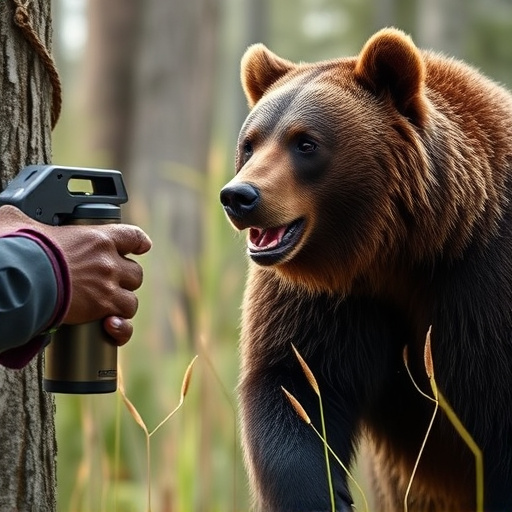Understanding bear behavior and habitat is crucial for safety in areas with bear presence. Bear spray, a popular deterrent, requires proper testing and adherence to the Bear Spray Testing Safety Guidelines for effectiveness without causing harm. Regular testing ensures users understand its range, usage techniques, and handling misfires or malfunctions. The guidelines include distance maintenance, avoiding sudden movements, and aiming directly at bears' faces during aggressive approaches. Correct procedures enhance safety in bear country.
“In areas where aggressive bears roam, understanding their behavior and having the right tools are essential for safety. This comprehensive guide explores outdoor protection measures against aggressive bears. We delve into the science behind bear habitat and behavior, focusing on the crucial role of bear spray as a deterrent. Learn expert tips on choosing, applying, and testing bear spray, along with safe storage practices. Additionally, discover alternative deterrents and navigate Bear Spray Testing Safety Guidelines for a secure outdoor experience.”
- Understanding Bear Behavior and Their Habitat
- Choosing and Applying Bear Spray Effectively
- Safety Guidelines for Testing and Storage
- Alternative Measures for Bear Deterrents
Understanding Bear Behavior and Their Habitat
Understanding bear behavior and their habitat is crucial for ensuring safety in areas where bears are present. Bears, particularly aggressive ones, often inhabit dense forests and remote regions, making them less predictable than other wildlife. Knowing when and where to expect bears can help hikers and campers avoid potentially dangerous encounters. Bear spray, a popular deterrent, requires proper testing and usage following safety guidelines to be effective without causing harm to humans or the environment.
Regular bear spray testing ensures that individuals using it are familiar with its range, usage techniques, and how to handle misfires or malfunctions. It’s important to follow safety guidelines that include keeping a safe distance from bears, avoiding sudden movements, and spraying directly into the bear’s face when approached aggressively. Understanding these dynamics can foster a harmonious coexistence between humans and bears, minimizing conflicts and enhancing overall outdoor safety.
Choosing and Applying Bear Spray Effectively
When considering outdoor protection against aggressive bears, bear spray is a crucial tool. However, its effectiveness hinges on proper selection and application. Choosing the right bear spray involves checking safety guidelines and understanding the recommended range and usage instructions. Bear spray testing involves more than just buying a can; it’s about ensuring you know how to deploy it accurately when needed.
Applying bear spray safely requires following specific steps. Stand your ground, make yourself appear larger, and raise your arms to signal your presence. When the bear approaches within the recommended distance, pull the trigger while aiming for the bear’s face and eyes. It’s important to note that one shot usually isn’t enough; be prepared to follow up with a second burst if needed. Regular practice in controlled environments can help you become more comfortable and confident in using bear spray effectively during actual encounters.
Safety Guidelines for Testing and Storage
When preparing for outdoor activities in bear country, proper testing and storage of bear spray is paramount. Always follow safety guidelines to ensure its effectiveness. Conduct regular Bear Spray Testing by aiming a small burst towards a non-porous surface at close range, simulating a real-world scenario. This helps maintain the spray mechanism’s integrity and ensures the can’s contents remain intact.
Store your bear spray in a cool, dry place away from direct sunlight or extreme temperatures. Keep it out of reach of children and pets. Bear spray should be secured to your person during outdoor excursions, typically on a belt loop or backpack strap, allowing for quick access when needed. Regular maintenance includes checking expiration dates and inspecting the spray nozzle for any blockages or damage.
Alternative Measures for Bear Deterrents
While bear deterrents like noisemakers and lights are popular, there’s a growing interest in alternative measures, notably bear spray. This non-lethal deterrent has gained traction for its effectiveness in repelling aggressive bears. However, it’s crucial to understand the Bear Spray Testing Safety Guidelines before use. Proper handling and application techniques are essential to ensure safety and maximize its deterrence capabilities.
Regular testing and updating of spray devices is recommended, as factors like expiration dates and environmental conditions can affect performance. Knowing the range, usage instructions, and de-escalation strategies specific to different bear species is vital for responsible outdoor practice in bear country.
Understanding bear behavior and their habitat is key to preventing and mitigating encounters. Choosing the right bear spray, proper application techniques, and adhering to safe testing and storage guidelines can significantly enhance your outdoor safety. Additionally, exploring alternative deterrents offers a multi-layered approach to protection. Remember, knowledge and preparation are essential tools in navigating potentially dangerous situations with aggressive bears. Stay informed, stay safe, and enjoy the outdoors responsibly.
